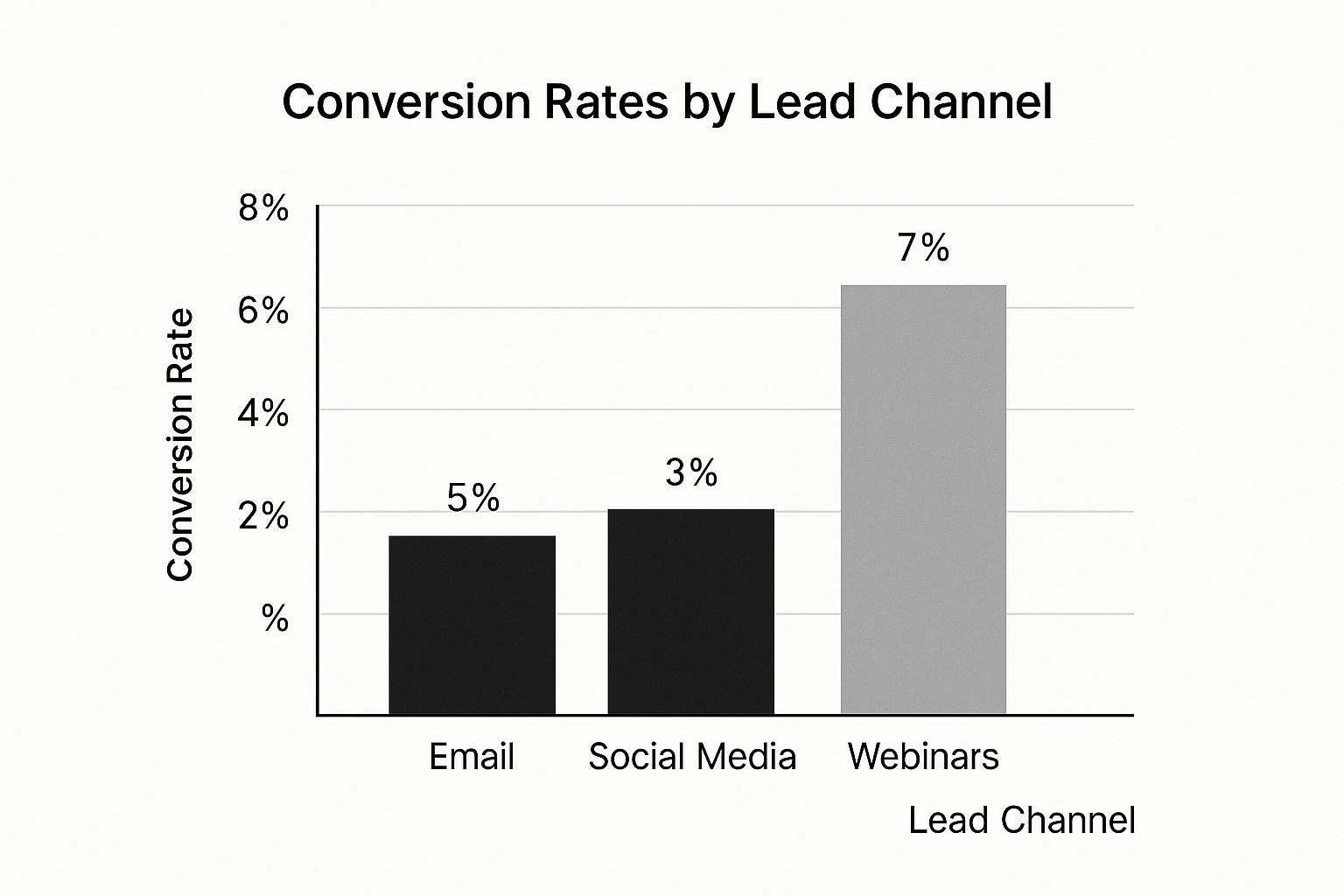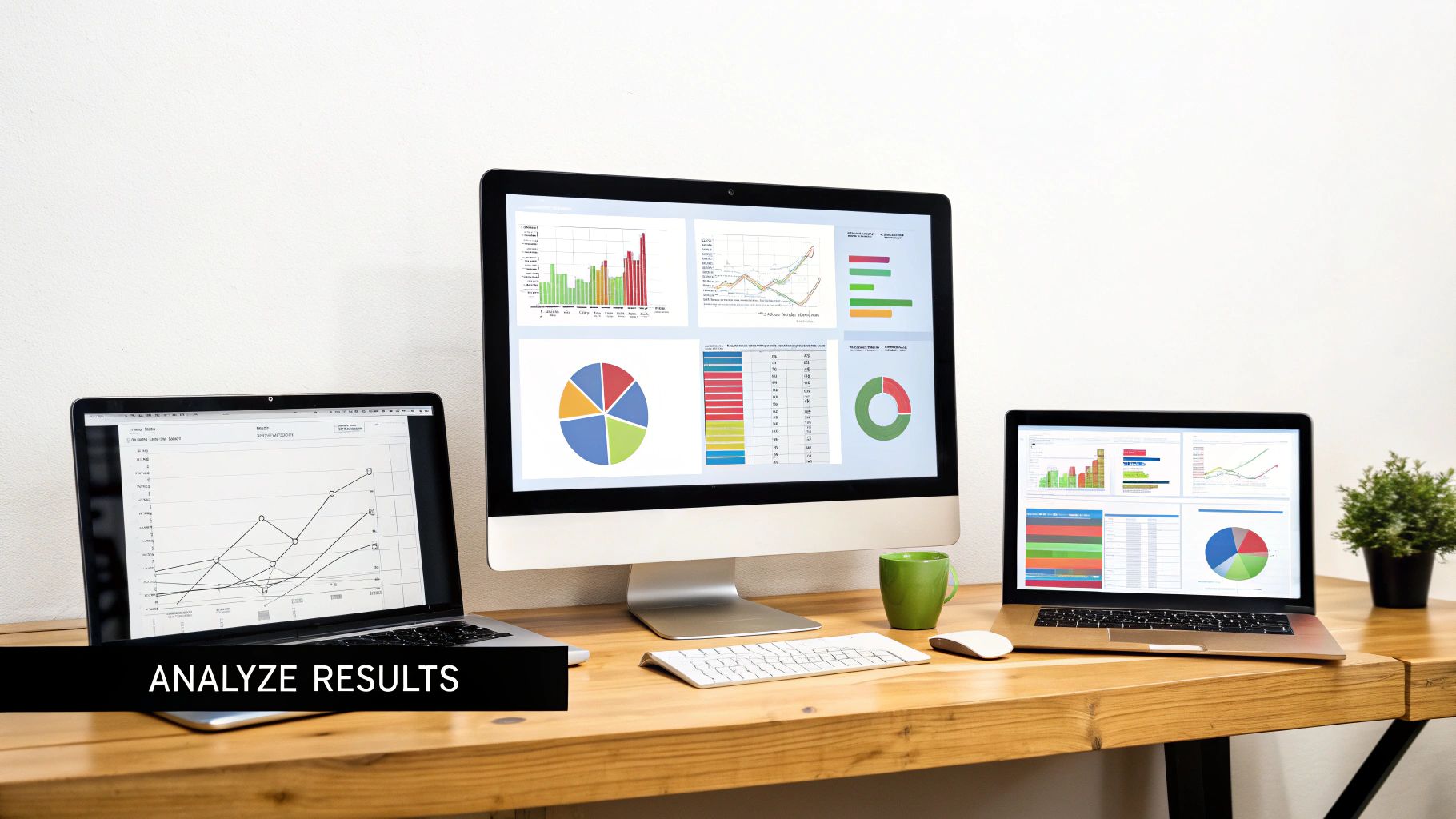B2B Lead Generation That Actually Works: Real Strategies
- Prince Yadav
- Jun 4
- 13 min read
Understanding The Real B2B Lead Generation Game
B2B lead generation is a competitive landscape. Many businesses struggle to find high-quality leads, often spending their budget without seeing the desired results. What separates successful companies from those struggling? It comes down to understanding the hidden costs, setting realistic expectations, and comparing performance against industry benchmarks. Want to learn more? Check out this helpful resource: How to master B2B Lead Generation.
The True Cost of Lead Generation
Many underestimate the investment needed for sustainable lead generation. It's more than just ad spend and software subscriptions. It includes your marketing team's time, content creation costs, and the expenses of lead nurturing and qualification. For example, creating compelling content requires significant time and resources, directly affecting the cost per lead. Failing to account for these often-overlooked costs can severely impact your ROI.
The average business generates around 1,877 leads monthly, with 81% qualifying as marketing-qualified leads (MQLs). This translates to roughly 1,523 MQLs per month at an average cost of $198.44 per lead, across all industries. This data underscores the financial commitment involved in effective B2B lead generation. For deeper insights, explore these statistics: Lead Generation Statistics. Understanding these benchmarks is key to setting realistic goals and budgets.
Setting Realistic Expectations and Benchmarks
Many businesses chase vanity metrics, prioritizing lead quantity over quality. A high volume of leads is meaningless if they don't convert into opportunities. This is where realistic benchmarks are essential. Instead of focusing on arbitrary lead numbers, prioritize the metrics that drive business growth, such as conversion rates and sales pipeline expansion. Comparing your performance against industry averages can help you identify areas for improvement and refine your strategies.
Measuring Success Beyond Vanity Metrics
Measuring success means looking beyond simple lead counts. It's like gardening: simply planting many seeds doesn't guarantee a bountiful harvest. You need to nurture them, provide the right conditions, and remove the ones that won't flourish. Focusing solely on the number of leads generated is like only counting the seeds planted. True success comes from tracking the entire lead lifecycle, from initial contact to closed deal. This involves measuring conversion rates at each stage of the sales funnel, identifying bottlenecks, and continually optimizing your strategies to maximize ROI.
Building Trust Through Content That Actually Connects

Authenticity is key in today's B2B marketing landscape. With the influx of AI-generated content, buyers are often overwhelmed with generic messaging. This makes genuine connection incredibly important. Smart B2B companies are adapting to this change by prioritizing trust-building through valuable, resonant content.
Content That Resonates With Decision-Makers
Decision-makers are constantly bombarded with pitches. To cut through the noise, your content must address their specific pain points and offer practical solutions.
Instead of simply listing product features, show how those features solve real-world problems. Case studies, client testimonials, and in-depth analyses build credibility and demonstrate expertise.
This approach establishes trust and positions you as a valuable resource, not just another vendor.
Educational Content as a Subtle Sales Tool
Educational content is an excellent way to showcase your expertise without resorting to overt sales pitches. Think of it as offering a valuable free sample.
By providing helpful information upfront, you demonstrate your knowledge and build trust with potential clients. This allows leads to experience the value you offer before committing.
Additionally, educational content boosts your search engine visibility, attracting more qualified leads organically. Check out this resource: How to master B2B lead generation.
Measuring the True Impact of Your Content
B2B lead generation is becoming more complex, with a growing focus on authentic content. This focus is partly due to the increased use of AI in content creation, which can sometimes result in less genuine content. Building trust through high-quality, authentic content is now essential for successful B2B lead generation. Learn more about the future of B2B lead generation.
However, measuring content effectiveness goes beyond tracking website visits or social media shares. The true impact lies in the quality of leads generated and their movement through the sales funnel.
Track metrics like conversion rates, lead scoring, and sales pipeline growth to understand the real effectiveness of your content strategy. These data points provide valuable insights into what resonates with your audience and what drives tangible business results.
Mastering High-Impact Lead Generation Channels
Not all B2B lead generation channels are created equal. Many companies invest in strategies that yield disappointing results, ultimately impacting their bottom line. This section explores the channels that consistently deliver high-quality leads and examines why some approaches outperform others.
The Power of Events and Webinars
Events and webinars provide a valuable opportunity to connect directly with potential clients. These platforms, whether in-person or virtual, allow you to showcase your expertise, build relationships, and generate qualified leads within a focused environment. This direct interaction offers valuable insights into customer needs and pain points, allowing for more effective follow-up and personalized nurturing.
Events and webinars offer valuable "face-time" with your target audience, building trust and potentially accelerating the sales cycle. This personal connection can be far more effective than other, less direct channels.
In B2B lead generation, channel effectiveness can vary significantly across industries. However, events and webinars consistently prove highly effective, with 32% of B2B marketers identifying them as a top lead generation source. Additionally, 91% of B2B marketers believe content marketing outperforms traditional channels. For more insights into these trends, explore these B2B lead generation statistics.
The infographic below visually represents conversion rate data across email, social media, and webinars:

As the data shows, webinars have the highest conversion rate at 7%, outperforming email at 5% and social media at 3%. This underscores the effectiveness of interactive, engaging content in capturing and converting leads. It also emphasizes the importance of choosing the right channels for your specific audience and business goals. For those interested in exploring other avenues, this article provides helpful tips on how to use cold emails to get more customers.
Optimizing Your Channel Mix for Maximum ROI
Finding the right mix of channels requires thoughtful analysis and strategic planning. Consider your target audience, industry, and budget when allocating resources. While some industries might find success with social media marketing, others may see better returns from targeted email campaigns or industry-specific events.
To get the most out of your lead generation efforts, the following table offers a comparison of different B2B channels:
B2B Lead Generation Channel Effectiveness Comparison: This table compares different B2B lead generation channels, highlighting their effectiveness rates, cost considerations, and best use cases.
Channel | Effectiveness Rate | Average Cost | Best For | Implementation Difficulty |
|---|---|---|---|---|
Events & Webinars | High (32% report as top source) | Moderate to High | Building relationships, showcasing expertise | Moderate |
Content Marketing | High (91% believe it outperforms traditional channels) | Moderate | Establishing thought leadership, attracting organic traffic | Moderate to High |
Email Marketing | Moderate (5% conversion rate) | Low to Moderate | Nurturing leads, targeted promotions | Low to Moderate |
Social Media Marketing | Low (3% conversion rate) | Low | Brand awareness, community building | Low |
Cold Emailing | Moderate | Low | Direct outreach, lead generation | Moderate |
This table helps illustrate the varying effectiveness and cost of different channels. While events and webinars boast high effectiveness, they can be costly. Conversely, social media and email offer lower cost options, but with potentially lower conversion rates.
A data-driven approach is essential for maximizing ROI. Regularly analyze channel performance, track key metrics, and adapt your strategy accordingly. This iterative process ensures continuous investment in the most impactful channels for your business. By understanding the strengths and weaknesses of each channel, you can build a comprehensive strategy that consistently generates leads and contributes to sustainable growth.
Smart Automation Without Losing The Human Connection

Automation and AI are transforming the world of B2B lead generation. However, if not implemented carefully, automation can detract from the personalized approach vital for closing deals. This section explores how successful companies use automation strategically, maximizing its benefits while maintaining the genuine connections that build strong client relationships.
Striking the Balance: Automation and the Human Touch
Many businesses make the mistake of over-automating, prioritizing efficiency over personalization. This often leads to generic, uninspired messaging that fails to connect with potential clients. The secret lies in identifying which processes are best suited for automation and which require a human touch.
Lead scoring and lead routing, for example, are ideal candidates for automation. AI-powered tools like HubSpot can efficiently analyze lead data and assign scores based on pre-defined criteria. This automation frees up valuable time for your team to focus on more personalized outreach to high-potential leads.
Building genuine relationships, however, still requires human expertise and nuanced communication. While automated email sequences can be part of a successful strategy, they should be personalized and used thoughtfully to nurture leads, not to replace genuine human interaction.
AI-Powered Lead Scoring and Nurturing
Effective lead scoring is critical for prioritizing your sales efforts. AI can analyze a wide range of data points, such as website activity, email engagement, and demographic information, to identify promising leads. This allows your sales team to concentrate their efforts on the most qualified opportunities. You might be interested in: How can you increase your SaaS customer base using cold emails?
Automated nurturing sequences can then guide these qualified leads through the sales funnel. These sequences should provide valuable content and address specific pain points, building trust and fostering a relationship before handing them off to the sales team.
Intelligent Lead Routing and Conversion Rates
Intelligent lead routing ensures that leads are directed to the appropriate sales representative at the optimal time. Automated systems can route leads based on factors like industry, company size, or location, ensuring efficient and personalized follow-up.
This targeted approach streamlines the entire sales process, minimizing delays and ensuring each lead receives the focused attention they deserve. This increased efficiency can result in a significant boost in conversion rates.
Measuring the Impact of Automation
Tracking the effectiveness of your automation strategy is crucial for ongoing improvement. Focus on metrics that directly affect your bottom line, such as lead-to-opportunity conversion rates, sales cycle length, and overall revenue generated.
By monitoring these key performance indicators (KPIs), you can pinpoint areas for improvement and ensure that your automation strategy contributes to tangible business growth. The goal isn't to automate for the sake of automation, but to achieve measurable results and continuously refine your approach.
Converting Leads Into Real Sales Opportunities
Generating leads is often the first hurdle B2B marketers focus on. But the real challenge? Turning those leads into actual sales. Many companies struggle with this, losing out on significant revenue. This section explores the critical link between lead generation and sales conversion, a gap that can cost businesses millions.
Why Most B2B Leads Aren't Sales-Ready
Many B2B leads simply aren't ready to buy right away. They might still be researching, comparing solutions, or haven't fully identified their needs. Expecting instant conversions from every lead is unrealistic and often leads to wasted effort and disappointment.
Think of it like building a relationship. You wouldn't propose on the first date! Similarly, expecting a lead who downloaded a whitepaper to buy immediately isn't realistic. Nurturing is key to building trust, educating prospects, and guiding them toward a sale. You might find this helpful: How We Helped a Client Build a $6.7M Pipeline.
Nurturing Leads Through the Sales Funnel
Effective nurturing means strategically guiding leads through your sales funnel. This involves providing valuable content relevant to their current stage in the buyer's journey.
For example, a lead in the awareness stage might benefit from blog posts or educational webinars. As they move to the consideration phase, case studies and product demos become more relevant. Finally, in the decision stage, pricing information and personalized consultations can help close the deal.
This targeted approach ensures leads get the right information at the right time, increasing their chances of becoming qualified sales opportunities.
Identifying Sales-Ready Indicators
Knowing when a lead is sales-ready is crucial. Certain signs indicate a prospect's readiness for direct sales engagement:
High lead score: Consistent interaction with your content, visiting key product pages, and other high-engagement behaviors show strong interest.
Requesting a demo or consultation: This proactive behavior signals a clear desire to learn more and discuss specific needs.
Engaging with sales-focused content: Downloading pricing guides or ROI-focused case studies shows a lead is nearing a purchase decision.
Recognizing these indicators lets your sales team engage at the right moment, maximizing their closing potential.
Improving Lead-to-Opportunity Conversion Rates
Improving conversion rates requires a comprehensive approach. This includes refining lead qualification, developing targeted nurturing sequences, and implementing effective follow-up strategies.
For example, a clear lead scoring system helps identify high-potential leads early. This enables more personalized outreach and boosts sales efficiency.
Strategic follow-up is also vital. Responding promptly to inquiries, providing relevant information, and maintaining regular communication builds trust and keeps you top-of-mind.
Lead Nurturing Strategy Framework
The following table provides a structured framework for lead nurturing:
Lead Nurturing Strategy Framework: Step-by-step framework showing lead nurturing stages, content types, timing, and conversion metrics.
Nurturing Stage | Content Type | Frequency | Key Metrics | Expected Timeline |
|---|---|---|---|---|
Awareness | Blog posts, webinars, social media content | Weekly | Website visits, content downloads | Several weeks |
Consideration | Case studies, product demos, white papers | Bi-weekly | Demo requests, contact form submissions | Several weeks to a few months |
Decision | Pricing guides, personalized consultations, proposals | Weekly or as needed | Sales calls, contract negotiations | A few weeks to a month |
This framework provides a structured way to nurture leads and move them toward sales readiness. Tracking key metrics at each stage lets you continually optimize your strategy for the best results. This data-driven approach ensures focused and effective efforts, contributing to increased sales opportunities and business growth.
Measuring What Matters and Optimizing for Growth

Effective B2B lead generation relies on consistent evaluation and improvement. This involves looking beyond superficial numbers and focusing on the key performance indicators (KPIs) that truly drive success. Forget vanity metrics; it's about understanding what fuels actual business growth.
Beyond Vanity Metrics: Focusing on What Truly Matters
Many businesses get sidetracked by appealing but ultimately meaningless metrics like website traffic or social media followers. While these numbers might look good on a report, they don't always translate into revenue. For example, high website traffic is irrelevant if visitors aren't converting into leads.
Instead, concentrate on metrics directly tied to revenue, such as conversion rates, cost per lead, and sales pipeline growth. These KPIs provide a much more accurate view of your lead generation program's performance.
Attribution Tracking: Connecting Marketing to Revenue
Knowing where your leads originate is crucial for refining your strategy. Attribution tracking helps link specific marketing activities to the revenue they generate. This means pinpointing which channels, campaigns, and content are most effective at driving conversions.
This data is essential for making informed decisions about how you allocate your resources. For example, if webinars are a significant source of qualified leads, you can invest more in developing and promoting them.
Measuring Lead Quality Over Quantity
Prioritizing lead quality over quantity is a cornerstone of successful B2B lead generation. It's not about the sheer number of leads, but attracting the right leads – those most likely to become paying customers.
This means focusing on targeted audience engagement, compelling messaging, and valuable content that resonates with your ideal customer profile. This precise approach ultimately leads to a more efficient and profitable lead generation program.
Identifying Bottlenecks in Your Conversion Funnel
A conversion funnel visualizes the customer journey, from initial contact to becoming a paying customer. Identifying bottlenecks in this funnel is vital for improving conversion rates.
Analyze each stage of the funnel to pinpoint where leads are dropping off. A significant drop-off between demo requests and sales calls, for instance, might indicate a problem with your demo process or follow-up procedures. Addressing these bottlenecks is key to optimizing your strategy and maximizing ROI.
A/B Testing and Data-Driven Optimization
A/B testing compares two versions of a marketing element, like a landing page or email subject line, to see which performs better. This data-driven approach allows you to make informed decisions about optimizing your strategy.
By constantly testing and refining, you can fine-tune your approach for maximum lead generation and measurable growth. This continuous optimization is essential for staying competitive and achieving long-term success in B2B lead generation.
Key Takeaways
This practical guide outlines how to build and refine a successful B2B lead generation strategy. We’ll cover key milestones, realistic timelines, solutions to common challenges, and frameworks for scaling your efforts. Each action item includes success criteria and next steps for continuous improvement.
Building Your B2B Lead Generation Action Plan
A strong B2B lead generation strategy begins with a detailed plan. This plan should clearly define your target audience, ideal customer profile (ICP), and key performance indicators (KPIs).
Define Your Ideal Customer: Understanding your ideal customer’s pain points, motivations, and buying behavior is crucial. This knowledge allows you to tailor your messaging effectively and select the most appropriate channels.
Set SMART Goals: Effective goals are SMART: Specific, Measurable, Achievable, Relevant, and Time-bound. A good example is aiming for a 20% increase in qualified leads within the next quarter.
Choose the Right Channels: Concentrate your efforts on the channels where your target audience is most active. This could include platforms like LinkedIn, relevant industry events, or targeted email campaigns.
A clear action plan provides a roadmap for your lead generation efforts, ensuring focused and efficient execution.
Realistic Timelines and Milestones
Setting realistic expectations is essential. B2B lead generation is a marathon, not a sprint. Building a sustainable program takes time and consistent effort.
Short-Term Milestones (1-3 Months): Initially, prioritize building your contact list, optimizing your website for conversions, and creating a consistent content calendar.
Mid-Term Milestones (3-6 Months): After the initial setup, focus on implementing lead nurturing sequences, tracking your key metrics, and starting A/B testing various elements of your strategy.
Long-Term Milestones (6-12 Months): As your program matures, refine your sales process, scale successful campaigns, and analyze data for continuous optimization.
Breaking down your goals into manageable milestones allows you to track progress and adapt your strategy as needed. This iterative approach helps you stay on course and achieve sustainable growth.
Troubleshooting Common Lead Generation Challenges
Lead generation programs inevitably face obstacles. Proactively addressing these challenges is key to long-term success.
Low Conversion Rates: If conversion rates are low, A/B test different elements of your website and landing pages to identify areas for improvement. Refine your messaging and make sure your call-to-actions are clear and compelling.
Poor Lead Quality: If your leads aren’t converting, re-evaluate your targeting criteria to ensure you're attracting the right audience. Improve your lead qualification process to filter out unqualified leads early.
Lack of Engagement: Experiment with different content formats and channels to discover what resonates with your target audience. Personalize your messaging and focus on providing valuable content.
Anticipating and addressing these common challenges helps keep your lead generation program on track and maximize its overall effectiveness.
Scaling Your Lead Generation Efforts
As your program matures, scaling your efforts becomes critical for continued growth. This involves expanding successful campaigns, exploring new channels, and using automation tools.
Automate Repetitive Tasks: Leverage marketing automation software to streamline repetitive tasks such as lead scoring, email marketing, and social media posting. This allows your team to focus on more strategic activities.
Expand to New Channels: Once you’ve successfully established a presence on one or two channels, consider expanding to new platforms to reach a broader audience.
Continuously Optimize: Regularly analyze your data and A/B test different components of your strategy to ensure continuous improvement and maximize your ROI.
Following this roadmap can transform your B2B lead generation program into a powerful engine for sustainable growth. Remember, consistent effort, data-driven optimization, and a focus on quality over quantity are the keys to long-term success. If you’re looking for support, consider a consultation with Fypion Marketing, a performance-driven agency specializing in cold email outreach. Their pay-per-meeting model ensures you only pay for qualified, booked meetings.
Article created using [Outrank](https://outrank.so)
Comments